Increased Certainty in the Assessment of Beneficiary Owner: Opportunity for Foreign Investors?
Tax China Commentary 2-2018
The State Administration of Taxation (“SAT”) issued Announcement on Issues Concerning ‘Beneficiary Owners’ in Tax Treaties, SAT [2018] No. 9, effective from April 1, 2018 (“Announcement 9”), which replaced the former Guo Shui Han [2009] No. 601[1] and SAT [2012] No. 30[2] by revising the ‘adverse factors’ for the assessment of beneficiary owners (“Assessment”), widening the scope of the ‘safe harbor’ rules, and allowing ‘look through’ for the Assessment with certain conditions, etc. Moreover, the SAT has issued an interpretation to Announcement 9 for further clarifications (“Interpretation”).
Tax Benefits of Beneficiary Owners
Under the prevailing Chinese Enterprise Income Tax (“EIT”) rules, a non-tax resident company, that either not having an establishment in China but deriving income sourced from China or having an establishment in China but the income derived is not related to the establishment in China, is subject to an EIT rate of 10% on the China-sourced income, including dividends, royalties and interest (“Income”). However, the Double Taxation Treaties between China and some certain contracting states (“DTTs”) provide reduced EIT rates in articles of dividends, interest and royalties for beneficiary owners.
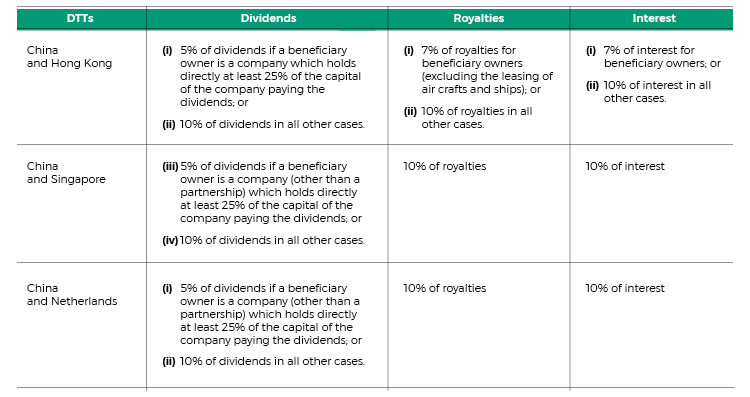
Following the introduction of SAT Announcement [2015] No. 60[3], which abolishes the application and approval procedures for treaty benefits and implements the reporting obligations of non-resident taxpayers or their withholding agents, requires the non-resident taxpayers or their withholding agents to assess the eligibility of treaty benefits on their own and to voluntarily report the need for the treaty benefits to the competent tax authority for future tax administration purpose.
The clarity and certainty in determining the beneficiary owner has been a challenging area for the foreign investors and the withholding agent of the foreign investors for many years. On one hand, Announcement 9 allows the beneficiary owners to enjoy the tax treaty benefits with more certainty and promotes the business environment. On the other hand, it clarifies the adverse factors which undermine the Assessment and therefore prevents the abuse of the DTTs. The said beneficiary owner is the non-resident taxpayer who has the voluntary reporting obligations for the treaty benefits and will be hereinafter referred to as “Self-assessor”.
“Adverse Factors” Assessment
The ‘adverse factors’ Assessment has been reduced from ‘7 adverse factors’ Assessment in Guo Shui Han [2009] No. 601 to ‘5 adverse factors’ Assessment in Announcement 9. Nevertheless, there has been no fundamental change in the Assessment, which continues to address the significance of ‘substantive business activities’. In general, the following five factors are regarded as adverse factors to the Assessment:
- The Self-assessor is obliged to pay more than 50% of the Income to a resident in a third country (region) within 12 months upon receiving the Income (“Factor 1”);
- The Self-assessor does not have substantive business activities (“Factor 2”). Substantive business activities include substantive manufacturing, distribution, management (such as management in investment holdings), etc. The level of the substantive business activities are assessed in accordance with the actual functions performed and the risk assumed; and
- The other contracting state (region) does not levy tax or grant tax exemption on the Income or apply an extremely low effective tax rate (“Factor 3”).
- Besides the loan agreement based on which the interest is generated and paid, there are other similar loan or deposit contracts in terms of amount, interest rate and execution date etc. between the Self-assessor (as debtor) and its creditor (“Factor 4”); and
- Besides the contract for the transfer of user rights in respect of copyright, patent or technology (“Royalty Contract”) based on which the royalties are generated and paid, there are other Royalty Contracts in respect of the right to use or the ownership of copyright, patent or technology between the Self-assessor (as licensee) and licensor (“Factor 5”).
Based on the above, the table below summarizes the applicability of each adverse factor for different types of Income.

Expanded Scope of ‘Safe Harbor’ Rules for Dividends
Guo Shui Han [2009] No. 601 and SAT [2012] No. 3 only allowed the Self-assessor to be eligible for beneficiary owner, provided that the Self-assessor receives dividends from a Chinese enterprise and is a listed company or 100% held by a listed company directly or indirectly in the same contracting state of the Self-assessor. In comparison, the prevailing ‘safe harbor’ rules have been expanded from listed companies in the other contracting states to governments and individual residents of the other contracting states.
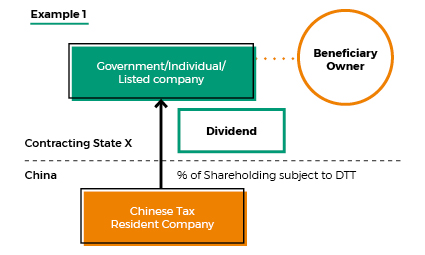
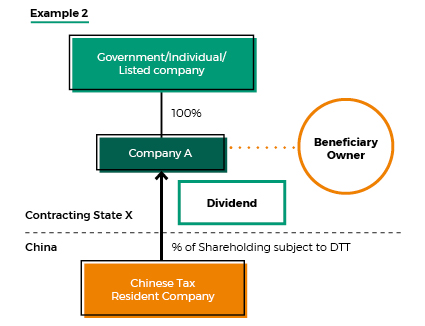
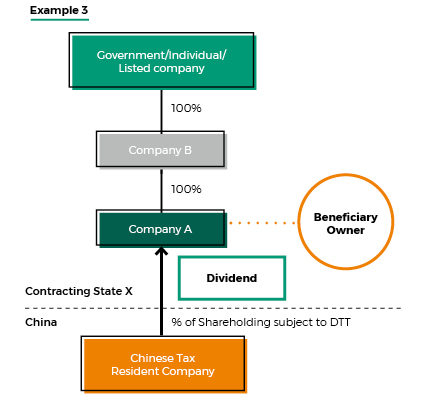
Exceptional Rules of Assessment for Self-assessors Receiving Dividends
Announcement 9 has further stipulated exceptional rules of Assessment for Self-assessors who receive dividends but cannot be assessed as beneficiary owner through the ‘adverse factors’ Assessment (“‘Adverse Factors’ Self-assessor”). The exceptional rules allow the ‘Adverse Factors’ Self-assessor to be recognized as a beneficiary owner and enjoy the DTT benefits of lower tax rates, provided that the shareholder of the ‘Adverse Factors’ Self-assessor, who directly or indirect holds 100% of shares of the ‘Adverse Factors’ Self-assessor, is recognized as a beneficiary owner (“Qualified Shareholder”) and meets one of the two conditions concurrently:
- The Qualified Shareholder is a resident in the same contracting state as the ‘Adverse Factors’ Self-assessor (“Condition I”); or
- The Qualified Shareholders and the intermediate shareholders are all eligible for the same or more preferential DTT benefits compared to the ‘Adverse Factors’ Self-assessor’s (“Condition II”).
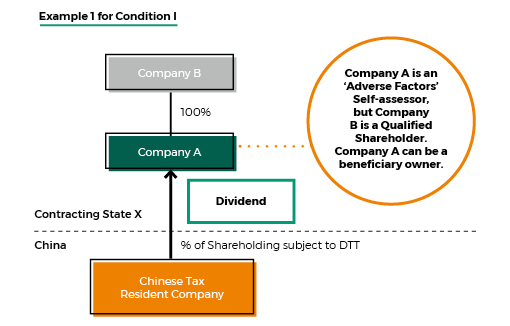
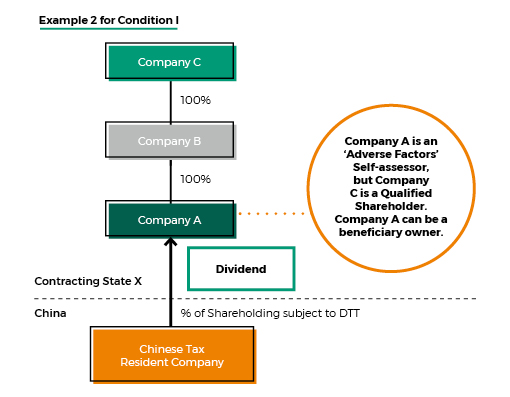

Other rules stipulated in Announcement 9
In addition to the above, Announcement 9 has also included the following aspects in relation to the Assessment:
- Agent or appointed payee, who receives Income on behalf of the beneficiary owner, will not be assessed as beneficiary owner nor has an impact on the Assessment in any case;
- Examples of supporting documents for the Assessment;
- Reference to SAT Announcement [2015] No. 60 for the procedures of enjoying DTT benefits;
- Requirement for competent tax authorities for the future tax administration of anti-tax avoidance; and
- The applicability of Announcement 9 to DTT between China and Hong Kong as well as DTT between China and Macau.
Commentary on Announcement 9
Announcement 9 and the Interpretation have increased the certainty in the Assessment for the concept of ‘substantive business activities’, widening the scope of ‘safe harbor’ rules and providing exceptional rules for ‘Adverse Factors’ Self-assessors to be recognized as beneficiary owners though the Qualified Shareholders . It is useful to the Self-assessors for evidencing the eligibility of beneficiary owners to the competent tax authorities and may reduce the discrepancy of the Assessment in local practices.
The understanding of beneficiary owner in international taxation generally concentrates on the degree of control over the Income. In comparison, the ‘adverse factors’ Assessment in Announcement 9 has more stringent requirements, where the degree of control is one of the factors among others. The ‘substantive business activities’ in the Assessment is an additional Chinese interpretation to the concept of beneficiary owner.
Furthermore, Announcement 9 requires the competent tax authorities to apply either the investigation procedures of general anti-tax avoidance rules under the domestic tax rules or the primary purpose test in the DTTS for the Assessment, if they identify any case of DTT abuse. The applications of the general anti-tax avoidance rules and the primary purpose test are questioned due to the lack of guidance on when and how can these be applied to or initiated on the Assessment.
[1] Guo Shui Han [2009] No. 601 refers to Circular on Understanding and Recognizing the ‘Beneficiary Owner’ in the DTTs, issued by SAT on October 27, 2009.
[2] Announcement of SAT [2012] No. 30 refers to Announcement on Determining the ‘Beneficiary Owners’ in the DTTs, issued by SAT on June 29, 2012.
[3] SAT Announcement [2015] No. 60 refers to Administrative Measures on Entitlement of Non-Resident Enterprises to DTT Benefits, issued by SAT on August 27, 2015.
Contacts


-
+34 95 207 55 25
